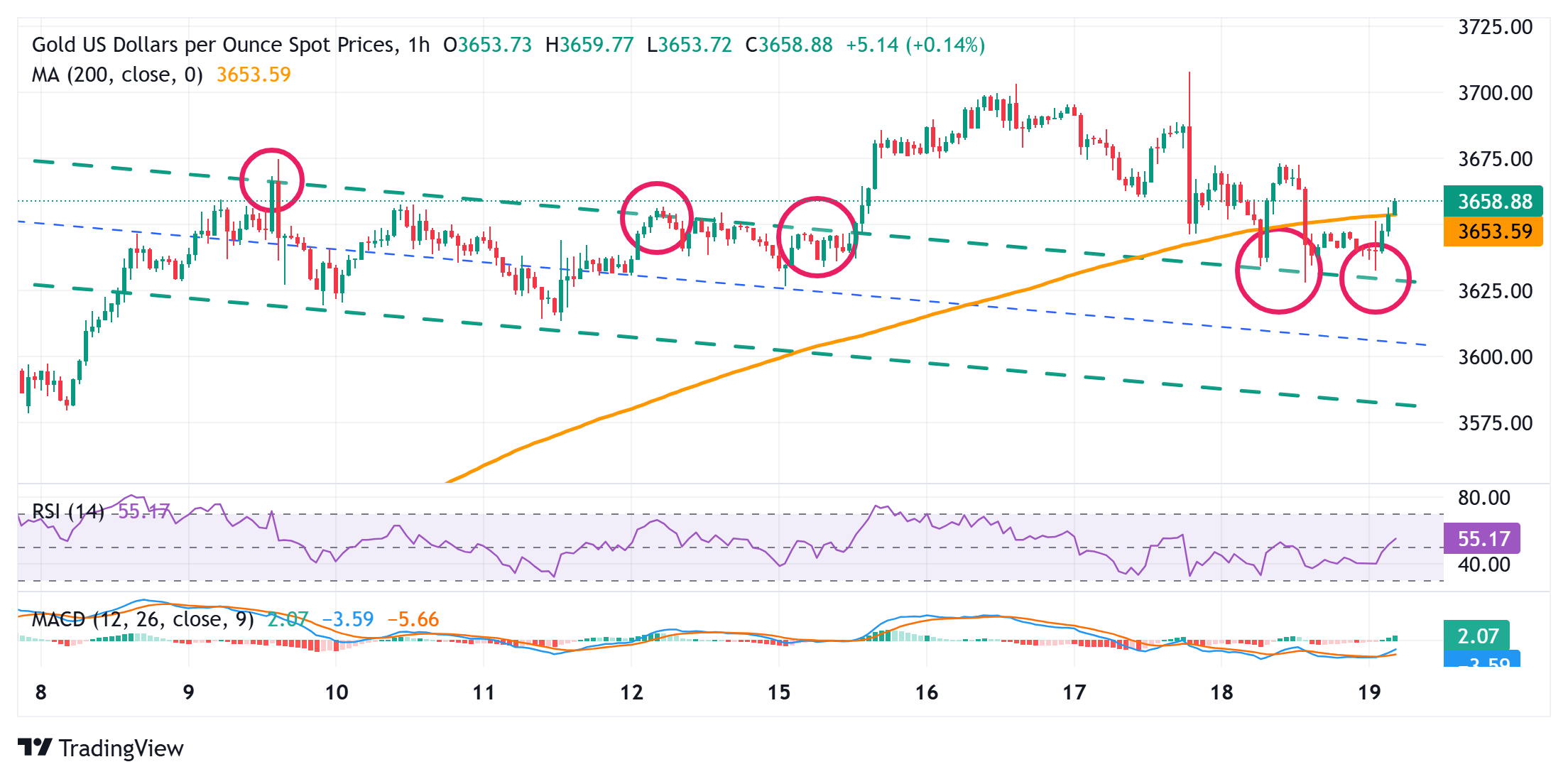Gold stalls corrective slide from record high as geopolitical risks boost safe-haven demand
- Gold catches some bids on Friday and stalls a two-day-old corrective slide from the all-time peak.
- Geopolitical risks revive demand for the safe-haven XAU/USD, though the upside seems limited.
- Fed Chair Powell’s stance of rate cuts underpins the USD and caps the non-yielding commodity.
Gold (XAU/USD) attracts some buyers near the $3,632 region during the Asian session on Friday and now seems to have stalled a two-day-old corrective slide from the all-time peak touched earlier this week. Geopolitical risks stemming from the intensifying Russia-Ukraine war and conflicts in the Middle East offer some support to the safe-haven precious metal. The upside potential, however, seems limited amid a firmer US Dollar (USD), which tends to undermine demand for the commodity.
The USD Index (DXY), which tracks the Greenback against a basket of currencies, looks to build on its recovery from the lowest level since February 2022 amid a hawkish assessment of Federal Reserve (Fed) Chair Jerome Powell's comments on Wednesday. This, along with a generally positive tone around the equity markets, might contribute to capping any meaningful appreciation for the non-yielding yellow metal, which, at current levels, remains on track to end nearly unchanged for the week.
Daily Digest Market Movers: Gold attracts safe-haven flows amid rising geopolitical tensions
- US President Donald Trump said on Thursday that his Russian counterpart, Vladimir Putin, had let him down and insisted that US allies must stop purchasing oil from Russia so that the ongoing war with Ukraine could come to an end. Moreover, the President of the European Commission, Ursula von der Leyen, said that the EU will propose speeding up the phasing out of Russian fossil imports.
- The Israeli army carried out several strikes on the densely populated towns in southern Lebanon, targeting Hezbollah’s military infrastructure. An army spokesperson said that the operation was being carried out in response to Hezbollah’s attempts to rebuild its activities in the area. This keeps geopolitical risks in play and offers some support to the safe-haven Gold during the Asian session.
- The US Federal Reserve, as was expected, lowered borrowing costs for the first time since December 2024 on Wednesday and indicated that more rate cuts would follow through the end of this year amid the softening labor market. However, Fed Chair Jerome Powell said that risks to inflation are tilted to the upside and added that he doesn't feel the need to move quickly on interest rates.
- Adding to this, data released on Thursday showed the number of Americans filing new claims for unemployment benefits fell sharply from a near four-year high and came in at a seasonally adjusted 231,000 for the week ended September 13. Furthermore, the Philadelphia Fed Manufacturing Index rose more-than-expected from 1.7 to 23.2 for September, or the highest level since January.
- This assists the US Dollar in preserving its strong recovery gains from a three-and-a-half-year low and holds back the XAU/USD bulls from placing aggressive bets. Hence, it will be prudent to wait for strong follow-through buying before confirming that this week's corrective pullback from the all-time peak has run its course and positioning for the resumption of the well-established uptrend.
Gold bounces off flag pattern resistance breakpoint, now turned support, near $3,628-3,626 area

The overnight acceptance below the 200-hour Simple Moving Average (SMA) – for the first time since August 22 – favors the XAU/USD bears. The subsequent fall, however, stalls near a bullish flag pattern breakpoint, around the $3,628 region. This, in turn, warrants some caution before positioning for any meaningful decline.
In the meantime, a further move up beyond the $3,660 area might confront some resistance near the $3,673-3,675 zone, above which the Gold price could climb back to the $3,700 neighborhood. Some follow-through buying beyond the $3,707 region, or the all-time peak, will be seen as a fresh trigger for bullish traders.
On the flip side, the $3,628-3,626 resistance-turned-support, or the weekly trough, could act as an immediate support ahead of the $3,600 mark. A convincing break below the latter could drag the Gold price to the $3,563-3,562 support en route to the $3,511-3,510 region. The said area is likely to act as a strong base for the XAU/USD pair.
Gold FAQs
Gold has played a key role in human’s history as it has been widely used as a store of value and medium of exchange. Currently, apart from its shine and usage for jewelry, the precious metal is widely seen as a safe-haven asset, meaning that it is considered a good investment during turbulent times. Gold is also widely seen as a hedge against inflation and against depreciating currencies as it doesn’t rely on any specific issuer or government.
Central banks are the biggest Gold holders. In their aim to support their currencies in turbulent times, central banks tend to diversify their reserves and buy Gold to improve the perceived strength of the economy and the currency. High Gold reserves can be a source of trust for a country’s solvency. Central banks added 1,136 tonnes of Gold worth around $70 billion to their reserves in 2022, according to data from the World Gold Council. This is the highest yearly purchase since records began. Central banks from emerging economies such as China, India and Turkey are quickly increasing their Gold reserves.
Gold has an inverse correlation with the US Dollar and US Treasuries, which are both major reserve and safe-haven assets. When the Dollar depreciates, Gold tends to rise, enabling investors and central banks to diversify their assets in turbulent times. Gold is also inversely correlated with risk assets. A rally in the stock market tends to weaken Gold price, while sell-offs in riskier markets tend to favor the precious metal.
The price can move due to a wide range of factors. Geopolitical instability or fears of a deep recession can quickly make Gold price escalate due to its safe-haven status. As a yield-less asset, Gold tends to rise with lower interest rates, while higher cost of money usually weighs down on the yellow metal. Still, most moves depend on how the US Dollar (USD) behaves as the asset is priced in dollars (XAU/USD). A strong Dollar tends to keep the price of Gold controlled, whereas a weaker Dollar is likely to push Gold prices up.

